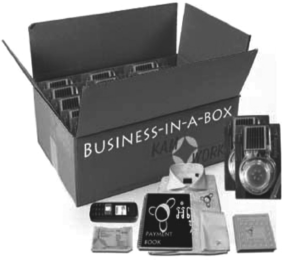G.5 Market and Business Considerations
G.5.1 Costs
The market price of the Moonlight, including the accompanying PV panel, is around US$25. Compared to a kerosene lamp of less than US$1, it is still a relatively high initial investment for a low-income family. What counts, in the end, is the life cycle cost, also called the cost of ownership: After purchase, operating costs determine the costs of ownership of a certain lighting option. Costs of operation comprise replacements of spare parts and costs of energy to power light, such as electricity for grid-connected lighting and fuel for kerosene lamps. Kerosene lamps have very high costs of ownership of US$12.00 per 1000 lux-hours, mainly due to fuel consumption. In contrast, a 1 W PV-LED lamp has costs of ownership of US$0.22 per 1000 lux-hours (Gooijer et al., 2008). In other words, a PV-LED-powered Moonlight has high initial costs, but in the short term these costs can be overcome and such light will save money for households.
G.5.2 Challenges with Market Implementation
Although feedback on the lanterns themselves is positive, and the return on investment is within one year, sales of the product are very challenging. In-field research revealed several main bottlenecks for the adoption of solar lanterns, such as the following:
- Up-front investment: Rural Cambodians often do not have the financial capacity to save money for large expenditures. Current lighting expenditure (purchasing kerosene) is done in small quantities, a few times a week. An investment of US$25 poses a barrier to purchasing a solar lantern.
- Education: Most rural villagers have little or no education. Basic education on the functioning of the product as well as the benefits of solar energy is needed for the rural population to adopt the (for them) new energy technology.
In order to remove the barrier of upfront investment, Kamworks is also piloting a Moonlight rental scheme. In this scheme, a village entrepreneur rents out 30–40 Moonlights to villagers at the same price as their daily average kerosene expenditure (approximately US$0.08 per day). In this way, the villager does not have to take any risk and does not have to make the upfront investment, but gets a much brighter, safer, and cleaner light than kerosene. The (carefully selected) village entrepreneur takes out a solar loan from the Micro Finance Institution and uses part of his or her revenue to pay it off. A rental business-in-a-box has all the components for a rental entrepreneur to start a business (Figure G.5.1).
Figure G.5.1 Business-in-a-box for rental entrepreneurs

G.5.3 A “Rent-to-Own” Business Model
However, a rental model, where customers pay a small weekly fee, also has multiple drawbacks: Customers have to pay a usage fee for an infinite period, making the product expensive in the long term; and the entrepreneur runs the risk that people can stop renting the lantern at any moment. Additionally, people are likely to be more careless with the lantern when they are only users and not owners. One solution directions can be found in a “rent-to-own” business model (see Figure G.5.2). In this setup, the customer rents the solar lantern from the entrepreneur for one year, and after that period, he or she will own the lantern (Elkhuizen, 2010).
Figure G.5.2 Different business models

The advantages of this setup are:
- This eliminates an upfront investment barrier.
- Local availability and services are provided by trusted entrepreneurs who are embedded in the local community.
- This increases the customer's care with the product and loyalty to the program, as well as fair pricing compared to a long-term rental scheme.
- It supports rural livelihoods.
- It can contribute to increased evening business activity, improved study conditions, and better general health and safety for rural villagers.
